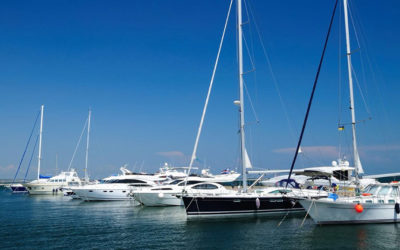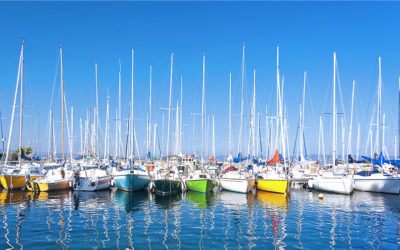Of all the equipment on your boat, some things are essential, including the windlass. It’s not that Band of Boats doubts your ability to raise the anchor yourself, but since a windlass makes sailing so much easier for you, why do without it?
1. What is a windlass?
The windlass is a big winch with a horizontal or vertical axis, whose purpose is to raise or drop the anchor quickly, easily, and reliably. It is located on the foredeck of the boat, and can be driven by a small motor (electric windlass) or a crank (manual windlass).
The winch is made up of two main components: the gypsy and the head. The gypsy is the notched ring that meshes with the links of the chain to hoist the anchor. It can rotate on a vertical or horizontal axis. The head is the smooth drum that raises the rode (textile part of the anchor). Both are driven by a series of gears that multiply the force. Note that, today, most gypsies perform both functions at the same time.
If it is an electric windlass, a gearmotor is added to the design.
2. How do you choose the right windlass for your boat?
There are several factors to consider when choosing the windlass. First, you need to know the overall length and displacement (light or heavy) of your boat to define the dimensions of the windlass. Once this step has been performed, we advise you to compare the traction power required for your boat to the traction power specified in the technical data sheet of the chosen windlass. The windlass power must obviously be higher.
For safe sailing, the traction capacity of the windlass must not be less than three times the total weight of the anchor line (anchor + chain).
3. Manual or electric windlass?
A manual windlass is lighter and cheaper than an electric windlass. It raises a heavy anchor effortlessly, but slowly. It is perfect for a boat without a battery or electrical charging system. However, if your boat is able to accommodate an electric winch, Band of Boats recommends that you have one.
The electric winch provides convenience and safety. It facilitates anchor manoeuvres by one person, and raises the anchor much more quickly. The quantity of anchor chain is also better controlled. Its only drawback is its high energy consumption, particularly when weighing anchor.
Hydraulic energy can also be used to operate a windlass.
4. Horizontal or vertical windlass?
Whether you choose a horizontal windlass or vertical windlass (capstan) mainly depends on how much space you have on the bridge and in the anchor well.
The available drop height is another important factor. This is the free length between the top of the chain bundle and the underside of the deck (see diagrams). A capstan (vertical windlass) needs at least 40 cm drop height, whilst a (horizontal) windlass only needs 30 cm. It’s up to you to assess your possible installation arrangements.
5. How do you install a windlass?
There are three rules to follow when installing a windlass:
- Make sure the gypsy is properly aligned with the roller
- Allow a distance of at least 1 metre between the two
- Maintain the correct angle of the chain on the windlass
The electrical installation must also be adapted accordingly. Because the windlass consumes a lot of electricity (more than 100 amperes) for very short times, an alternator and battery with appropriately sized wiring must be provided.
Finally, the windlass is controlled using a two-button control unit (up/down). You can choose between a footswitch and a wired or wireless remote control.
Band of Boats hopes you now have a clear understanding of the essential role and specific features of the windlass. Don’t hesitate to share your windlass experiences with the community!

